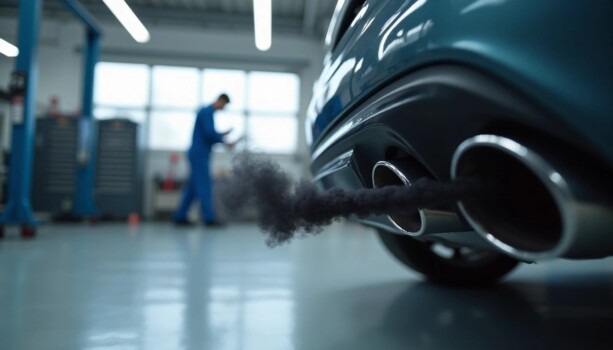Dark plumes billowing from your exhaust pipe tell you something’s wrong with your vehicle. Diesel vehicles might have a faulty EGR valve that gets pricey to fix at £534.77. Petrol cars could suffer from sensor malfunctions, and these mechanisms need quick attention. The biggest problem shows up especially when you have black smoke during acceleration because your engine works harder but wastes fuel.
This piece explains what makes both diesel and petrol engines produce black smoke from their exhausts. Air filter problems can boost particulate matter by 40-50%. You’ll learn useful diagnostic steps and economical solutions that help avoid expensive repairs later.
Understanding Black Smoke from Exhaust

Black smoke from exhaust happens when your engine burns too much fuel without enough air. This imbalanced air-to- fuel ratio leads to “running rich,” which means incomplete combustion creates soot particles that come out through your exhaust system.
What causes black smoke from exhaust?
Basically, black smoke appears because of unburned fuel particles. Your engine might face several mechanical issues:
Clogged air filters limit airflow to the combustion chamber and can increase particulate emissions by 40-50%
Faulty fuel injectors that stay open or get damaged and spray excess fuel
Damaged piston rings let engine oil leak into the combustion chamber
Sensor malfunctions, especially oxygen and Mass Airflow (MAF) sensors that control the fuel mixture
Engine deposits build up over time and affect performance
You’ll notice black smoke more when accelerating because your engine needs more fuel to boost power. Black smoke during acceleration usually points to a failing fuel system component.
Is black smoke dangerous for your vehicle?
Black smoke shows your engine isn’t working efficiently, which hurts both your vehicle and the environment. Your car wastes fuel, loses performance, and might face serious mechanical problems if you ignore these signs.
Worn diesel injector nozzles and needles can raise particulate emissions by up to 85%. Engine wear causes excessive oil consumption that also increases particulate matter by 85%. These problems compound each other quickly.
Diesel vehicles often show black smoke when their Exhaust Gas Recirculation (EGR) valve or Diesel Particulate Filter (DPF) fails. These parts play a vital role in controlling emissions.
Differences between diesel and gasoline engines
Both engines can produce black smoke through different processes:
Diesel engines create more emissions than gasoline engines naturally. Higher compression ratios and fuel injection systems make them prone to black smoke when the air-fuel mixture gets unbalanced. Turbocharger issues and clogged EGR valves often cause problems in diesel engines.
Gasoline engines usually produce black smoke because of bad sensors, carburetor problems in older models, or fuel system issues. Modern gasoline engines use electronic fuel injection systems to keep optimal air-fuel ratios, so they produce black smoke less often than diesel vehicles.
Your engine type doesn’t matter – black smoke contains elemental carbon, semi-volatile organic hydrocarbons, and harmful compounds like arsenic, benzene, and nickel. Quick diagnosis and repair are essential.
Common Causes and Immediate Fixes
Mechanics usually look at five main areas of your engine system to fix black smoke problems. Let me walk you through the specific signs and solutions for each issue.
Air Supply Issues: Clogged Air Filters
Your engine’s combustion chamber needs proper airflow. Dirty or clogged air filters block this flow and make your engine run on too much fuel. This imbalance can push emissions up by 40-50%. The solution is simple – you should check your air filter and replace it every 15,000-30,000 miles. This basic maintenance step helps your engine burn fuel better and stops black smoke.
Fuel System Problems: Faulty Injectors and Regulators
Bad fuel injectors can’t deliver the right amount of fuel to your combustion chamber. Injectors that stay open let too much fuel in, which creates carbon buildup and black smoke. A broken fuel pressure regulator raises system pressure and hits your fuel economy hard. You can fix minor problems by cleaning injectors with special cleaners. Badly damaged parts need professional replacement.
Sensor Malfunctions: Oxygen and MAF Sensors
Your oxygen sensor tells the engine control unit about unburned oxygen levels to control the air-fuel mix. A bad sensor makes the engine use too much fuel, which wastes gas and creates black smoke. The MAF sensor works the same way – if it’s dirty, it sends wrong airflow data to the computer, which leads to too much fuel injection. You can clean these sensors with isopropyl alcohol, but ongoing issues mean you need new sensors.
Engine Component Damage: Piston Rings and Turbochargers
Bad piston rings let engine oil leak into the combustion chamber. The mix of oil and fuel creates thick black smoke. Cars with turbochargers face different issues – a failed turbo throws off the air-fuel balance, which shows up most during acceleration. These complex problems need a professional mechanic’s diagnosis to prevent bigger engine issues.
Black Smoke From Exhaust When Accelerating: Special Considerations
We see black smoke mostly during acceleration, which points to specific problems. Your engine burns more fuel under load, which makes existing issues more obvious. Smoke during acceleration often means you have injector problems, turbo issues, or bad sensors that only show up under strain. On top of that, engine deposits that build up over time can cut performance and cause smoke specifically as you accelerate.
Advanced Diagnostic and Repair Procedures
Black smoke from your exhaust needs sophisticated diagnostic techniques that go beyond visual checks. Your modern vehicle’s computer systems can provide valuable data through proper access methods.
Using OBD Scanners to Identify Specific Issues
OBD-II scanners plug directly into your vehicle’s diagnostic port. You can find this port under the dashboard close to the steering column. These devices read error codes that your car’s computer stores whenever problems occur. All vehicles built after 1996 use standardized OBD-II codes that help mechanics trace specific black smoke emission problems.
Here’s how to use an OBD scanner:
- Locate your vehicle’s OBD port and connect the scanner
- Turn the ignition to “On” position without starting the engine
- Follow the scanner’s menu to access diagnostic functions
- Record any error codes to investigate further
Advanced scanners offer live data readings and freeze frame information. These features capture vital parameters right when a fault happens.
Professional Repair vs. DIY Solutions
Some signs tell you it’s time to seek professional help instead of DIY repairs. Watch out for major power loss, poor fuel economy, rough idling, or strange engine noises along with black smoke. Professional diesel technicians have specialized tools. They run smoke tests to find intake system leaks and perform injector balance tests that spot underperforming fuel injectors.
Complex problems with fuel injectors, turbochargers, or internal engine parts need professional diagnosis. This approach finds the root cause quickly and applies the right fix the first time. Fixing the wrong part can cause more damage and lead to costlier repairs.
Diagnostic testing costs range from AED 367.19 to AED 734.39. Labor charges vary between AED 238.68 and AED
624.23 per hour based on repair complexity. Small exhaust leaks might need just epoxy or tape as temporary fixes.
Serious problems require new components, including flange gaskets that seal parts properly.
Preventing Future Black Smoke Problems
Good maintenance stops black smoke problems from coming back after repairs. Your engine will last longer and produce less harmful emissions when you take care of it properly.
Regular Maintenance Schedule
The best way to avoid black smoke is to stick to what your manufacturer recommends. A new air filter every 15,000- 30,000 miles lets the right amount of air reach the combustion chamber. This simple fix cuts down particle emissions by 40-50%. Regular oil changes with quality oils that have detergent additives help prevent carbon buildup.
Diesel engines need their injectors checked and cleaned from time to time. Carbon deposits build up in injectors and chambers over time. This hurts fuel economy and creates more smoke. Clean or new injectors prevent the 85% jump in harmful emissions that worn ones can cause.
Fuel Quality Considerations
Your choice of fuel changes what comes out of your exhaust. AAA research shows cars running TOP-TIER fuel had 19 times less carbon buildup than those using basic fuel. These better fuels have extra cleaners that help stop carbon deposits.
You can use fuel additives with polyether amine (PEA) if premium fuel costs too much. These clean intake valves and injectors well. Diesel engines run better with higher cetane rated fuels that burn cleaner and make less smoke. Adding detergent to diesel fuel helps remove deposits that create black smoke.
Early Warning Signs to Watch For
You can catch problems before smoke appears. Lower fuel economy often shows up first. Black smoke during startup that goes away once the engine warms up points to cold start enrichment system problems.
Look at how smoke behaves during acceleration. Too much smoke under load usually means injector or sensor issues. Diesel cars need weekly highway drives. This lets the EGR valve get hot enough to burn off extra carbon. Fixing this early saves you from a £534.77 replacement cost.
Don’t wait for constant smoke to appear. Fix any occasional smoke, rough idling, or acceleration problems right away.
Conclusion
Black smoke coming from your exhaust is a clear sign of a serious problem that needs quick attention. We’ve seen how wrong air-fuel mixtures create these harmful emissions that can increase particulate matter by 85% in the worst cases. Your best defense against these problems starts with regular maintenance. You should replace air filters every 15,000- 30,000 miles and use quality fuel with proper detergent additives as part of your car’s care routine.
Your vehicle’s type and symptoms determine the best diagnostic approach. Diesel engines don’t deal very well with EGR valves and often have turbocharger problems. Gasoline engines usually face sensor malfunctions and fuel system issues. Black smoke shows incomplete combustion, so fixing the root cause works better than treating just the symptoms.
Your car’s behavior gives important clues – smoke during acceleration points to different problems than constant emissions. An OBD scanner helps start the diagnosis, but complex problems with injectors or internal engine parts need professional help. Knowing whether to fix it yourself or get expert help saves time and money.
Budget-friendly prevention works best against exhaust smoke problems. Watch for early warning signs like poor fuel economy or occasional smoke in specific driving conditions. This helps catch problems before they turn into major repairs. Good maintenance now protects your engine’s health, your budget, and our environment from harmful emissions later.
FAQs
Q1. What causes black smoke from a vehicle’s exhaust?
Black smoke typically indicates an imbalanced air-to-fuel ratio where the engine is burning excessive fuel with insufficient air. This can be caused by clogged air filters, faulty fuel injectors, damaged piston rings, or sensor malfunctions.
Q2. Is it safe to drive a car that’s emitting black smoke?
It’s not recommended to drive a vehicle producing black smoke. This can lead to further engine damage, increased emissions, and potential legal issues. It’s best to have the vehicle inspected and repaired by a qualified mechanic as soon as possible.
Q3. Can regular maintenance prevent black smoke issues?
Yes, regular maintenance is crucial in preventing black smoke problems. This includes changing air filters every 15,000-30,000 miles, using high-quality oils, and following manufacturer-recommended service intervals. These steps can significantly reduce the risk of black smoke emissions.
Q4. How does black smoke differ between diesel and gasoline engines?
Diesel engines are more prone to producing black smoke due to their higher compression ratios and fuel injection systems. Common causes in diesel engines include turbocharger problems and clogged EGR valves. In gasoline engines, black smoke is often due to sensor malfunctions or fuel system problems.
Q5. What should I do if I notice black smoke during acceleration?
If you notice black smoke primarily during acceleration, it often indicates a fuel system component failure, such as injector problems or turbocharger issues. It’s advisable to have your vehicle inspected by a professional mechanic to diagnose and address the specific cause.



